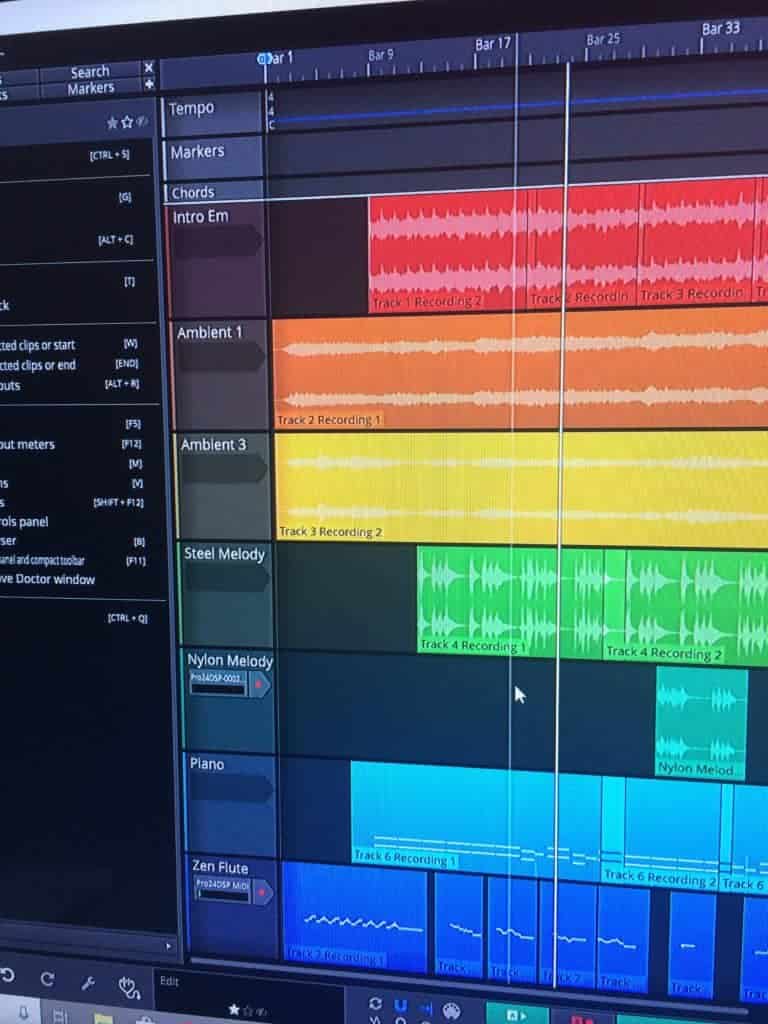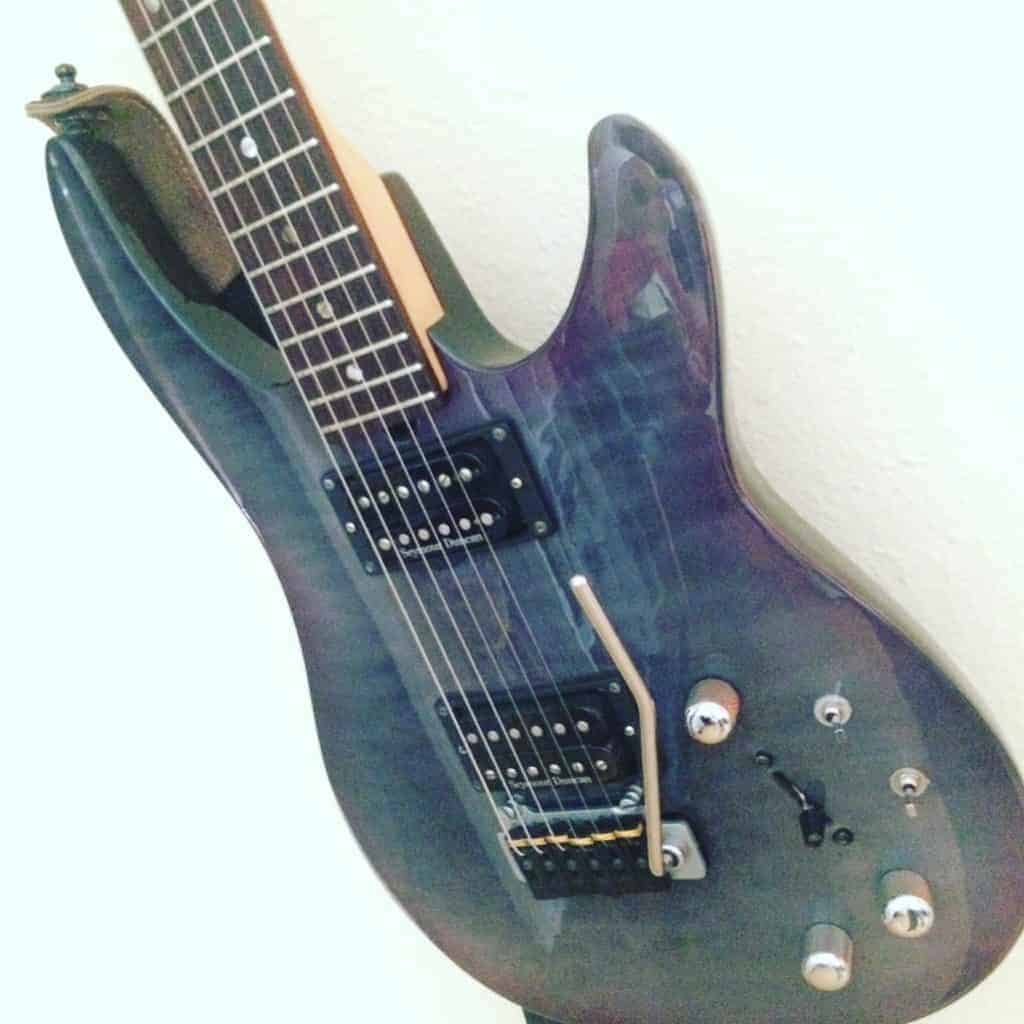The Clips
I am starting this blog with sound clips, so you can listen while you read (or if you don’t care that much about the artist/process stuff). The first clip is the first several minutes from one of the pieces. The second is an edit from four different pieces.
When working on a new recording, an artist has to decide why exactly they want to record this particular collection of songs. Sometimes these are the songs that come to them. Sometimes they have a theme, like Christmas songs. Sometimes they write songs they believe people expect from them, or that they know they can sell easily.
Well, I don’t take the easy road here. I decided to release 32 pieces of music in one collection because I believed that what was being sold as meditative music didn’t quite do that job for me. I regularly use music to sleep, and there were either repetitive sounds, overly dense arrangements, or environmental sounds added to the composition that didn’t add to the experience for me. I needed music that evolved over time, that had a similar sound, but nothing too obtrusive. I continue to use Brian Eno’s Ambient albums, and Chuck Wild’s Liquid Mind series, as these are closest to what I had in mind. A guitarist isn’t the first choice to put out a massive collection that doesn’t use distortion, power chords, rockin’ solos, and all of the other trappings of a guitar-based solo album, and that is precisely why I avoided those things.
So, tired of complaining about the fact I couldn’t find the music I needed to wind down from the day, I decided to write it and record it myself.
This set consists of 31 15-minute pieces (with an extra bonus one) designed to listen to while getting ready for the day or winding down from it. They could be used for sleep, meditation, yoga, etc- a different one for every day of the month. The bonus day was used for an unrelated commercial while wrapping up this project. It is very different than the other 31 days, but I decided to include it anyway.
The Gear
To understand how I recorded this, you might have to understand how I’ve recorded ambient albums in the past. I used a combination of guitar synthesizer (a device that uses samples of electronic and orchestral instruments), signal processing of a normal electric guitar signal, and a special pickup on my Brian Moore Custom Guitar (called a piezo) that can sound like an acoustic guitar. I would send these signals to a mixer and then to the best looping device ever made, an Oberheim Echoplex Digital Pro.

The Echoplex was built in the mid 90s, and was mono. So stereo signals collapsed into mono, and were sent out of my mixer’s aux out to return back into a channel of the mixer and mixed with (stereo) live playing. The biggest development, gear-wise, of the UBU project is that I was able to find a second working Echoplex, which can be sample-synced to the first one to provide stereo. So my loops could finally capture the left-right swirly-ness of the sounds I was using. It is very important to me that the audience can’t hear the difference between live playing and the loops, and with this second Echoplex, it was possible. While the Echoplex is pretty old, it does some things that no current looper can do (and looper manufacturers don’t even think about).
I also started recording using my trusty guitar synth and a great early 90s Roland synth, the M-GS64. After 17 of the 15-minute recordings, I took a break for about a month and listened back to what I had. While I liked the synth I had recorded, it wasn’t terribly different from what I had recorded in the past. I used familiar compositional techniques, and built my loops in a similar way that I had before. So, I scrapped these recordings (don’t worry, I will use them for something!), and decided to radically change the gear and method in which I recorded.
I decided, for the first time in 20 years, and the first time on recordings, to not use the guitar synth. The sounds would be purely manipulated electric guitar sounds, but I then had to figure out what that means to this project, as well as to my ears.

The device I used was called the Fractal AX8, and it essentially provides computer models of vintage and modern effects and amps. So instead of plugging the guitar into an effects pedal and then an amp, I use this magic box and create sounds using a computer editor. I built most of my sounds from scratch, while downloading and modifying a few more. The sounds are hardly identifiable as a guitar (this was the point), and further modified with long reverbs and pitch transposers. These sounds are output in stereo to my newly stereo loopers, and the output of those loopers went straight into my computer for recording (no mixer). The DAW I used to record was Steinberg’s Wavelab Essentials. So to come up with new music, I had to come up with a different way of making it.
The Method
I started looping in the early 80s using reel-to-reel tape decks, and later, long delays. Looping is a lot more popular now, and you generally hear someone build up a loop and play over it. But to make new music, I wanted to approach things a little differently. I wanted the loop to constantly decay over time. One of the problems I had with contemporary loop performance is the repetition. And repetition is one thing I wanted to avoid in my performance.

The loops I built were maybe between 10-20 seconds, and would repeat about five times before they were inaudible. So I had to continue playing, constantly adding to the loop. Now if I closed the loop, and played over the top, it would gradually disappear over a minute or so. If I kept the loop recording while it decayed, it would constantly change. To me, it is like being a kid and sitting in the backseat of the car on a long trip (before devices made that bearable). You see cars, people, cities, trees…the same things, but it is never quite the same. This is the feeling I wanted to create and capture with these recordings.
Sometimes I used 2 or 3 loops at once, that were not rhythmic, and didn’t sync up in any way. The sound of them blending together, never quite the same, was interesting to me, and quite a challenge to make them work together musically.
Oh yeah, they were also recorded in one take, live. A few didn’t make it- there were technical problems, or I played something I didn’t intend and I couldn’t recover them. But all of these (save for Day 32) were recorded live. Many of them were also live-streamed on Facebook as I recorded them.
The Release
The music business has changed a lot. It isn’t viable for many artists to get CDs manufactured, and I don’t know many people that actually listen to CDs anymore. To the artist, CD manufacturing is expensive, and boxes of these things take up a lot of room! Also, releasing 8+ hours of music at once would require a box set of 9 CDs (!) and until record companies start paying artists again, that ain’t happening. So the decision was made to release this whole set digitally, as a single release. Releasing a normal album this way isn’t too hard: record, copyright, pay a company to get it to your favorite download and streaming sites. But it isn’t that easy, and there are a few steps to take, especially with something this size.

To start with, most services that will make your music available through streaming services, downloadable files, and via YouTube don’t know what to do with a release of this size. Several of these services just flat-out declined. CD Baby worked with me to get it released, and now I know how to deal with other long-form releases I may have coming up.
The fun part of being an artist is creating the music. Unfortunately, a modern artist has to learn about a whole bunch of stuff that has to do with the business of music, and not the music itself. From promoting, to designing websites, booking shows, publishing, distributing, album art, etc…it all falls on the artist these days. Very, very few of us have a team of people to do these specialized tasks. However, the more an artist knows about the business side (and it is always changing), the more control the artist has. When we can finally pay people to help (or be lucky enough that someone else pays), we can understand the task. This is ultimately a great position to be in, but not so fun when you are trying to figure out why a menu doesn’t work on your own website, or trying to get ISRC codes to the Copyright Office.